Page 2 - Box Contents and Features
Box Contents & Features
But before we jump into the meet 'n greet, first let's get a little background on what we're dealing with. Creative launched the X-Fi in its various flavors back in August 2005 with generally excellent reviews. It came bristling with lots of features, the new EAX 5.0 HD, a very nice and shiny 10,000 MIPS audio processor, and a huge software bundle. Our X-Fi XtremeMusic has been our reference since then. Then along came Vista, Microsoft's successor to Windows XP. One large change, among other things, is how Vista dealt with audio. Since Vista does not allow direct access to hardware, so went DirectSound, and with it much of Creative's advantage in the sound card market.
Of course, Creative got creative and released OpenAL (ALchemy is the product) that enables Creative's EAX library of envronment and 3D effects with Vista so that you can at least get some games working with EAX. This change also opened up Creative to the idea of licensing its technology to other companies, like Auzentech, MSI, and others, to design sound cards based on Creative's chips and drivers.
So, this is Auzentech's X-Fi Prelude 7.1, the first sound cards based on Creative technology.
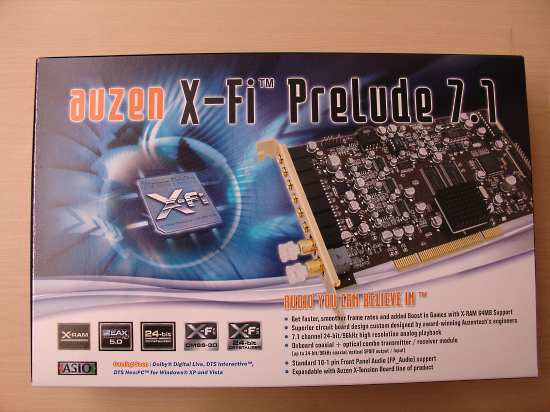
Auzentech took a different direction with the packaging, instead of their usual orange and black color scheme, this time it's blue and black. Here's a short list of features from the box:
-
X-Fi processor, 10,000 MIPS of power
-
64MB of X-RAM
-
7.1 channel 24 bit/96 KHz analog output
-
Coaxial+optical combo transmitter and receiver (up to 24 bit/96 KHz)
-
ASIO for low latency recording capability
-
EAX Advanced HD 5.0, including 24-bit Crystalizer, and CMSS-3D for games
-
Expandable with Auzentech's X-Tension line of daughtercards
For the real solder-sniffers out there, here are the chips:
-
High-end AKM DAC's (AK4396VF) and ADC (AK5394AVS)
-
National Semi LM4562 op-amp on the front channels
-
TI OPA2134 op-amps on the center/sub/surround channels
If I were out shopping and just reading the X-Fi Prelude's box, my eyes would have popped out.
Sliding off the cover reveals this:
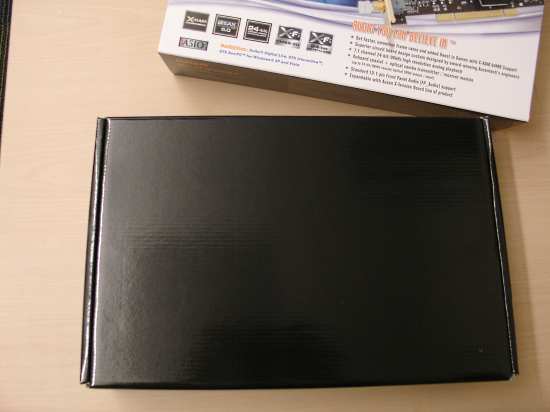
A black monolith! Open the pod bay doors, Hal. My eyes are popping, Hal, open the doors. Hal...
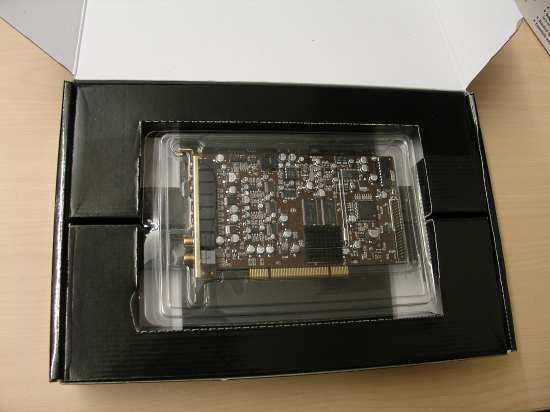
While you're viewing the box photos, let me continue with the theme from the top of the page. What makes X-Fis different from other sound cards is the CA20K1 DSP/APU, which Creative says can do a whole lot of math, real fast. The X-Fi product line also has several other features like the X-RAM on the X-Fi Elite Pro and Fatal1ty models, but they all generally feature the same 24 bit/96KHz recording and at least 24 bit/96KHz playback in 7.1 channels, and EAX 5.0 for Windows XP or OpenAL/ALchemy for Vista.
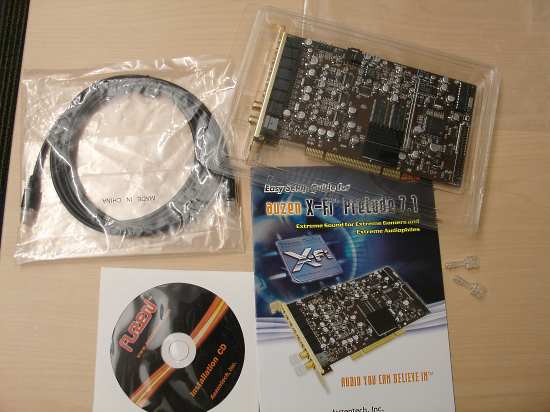
The biggest feature of the X-Fi, at least to my mind, is the high-quality sample rate conversion (SRC). This feature was one of the Audigy 2s sticking points. The old Audigy 1 and 2 upsampled or downsampled (if you left certain EAX effects running) all audio to 48 KHz. Since CDs are invariably encoded at 44.1 KHz, this upsampling to 48 KHz would cause measurable loss in fidelity. Whether the average listener could hear the difference is another story, but it certainly didnt look good on paper.
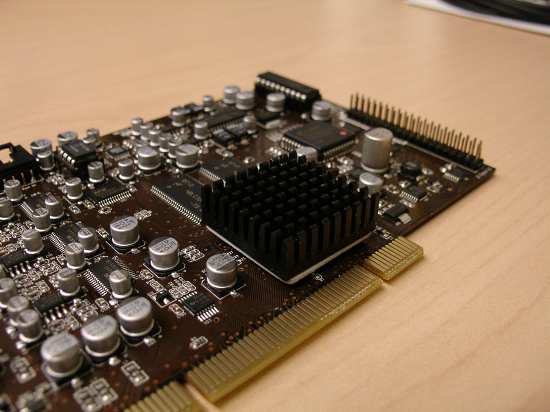
While Im on the subject of SRC, let me clear up some misconceptions about how the X-Fi Prelude deals with it. By working at the highest common denominator of 192KHz, the SRC is able to convert any digital signal into another with excellent precision and virtually no loss of fidelity. I will venture to say that Creative is very proud of this chip. Im glad to see it out and about on a different brand of card.
Here's a better shot of the X-Fi Prelude's X-RAM. Supposedly the SoundBlaster AWE32 had the option to add RAM to it, too. The X-Fi uses it to cache sounds and data while its working. I believe it is a worthwhile technology, and I'm glad to see Auzentech include it on the X-Fi Prelude.
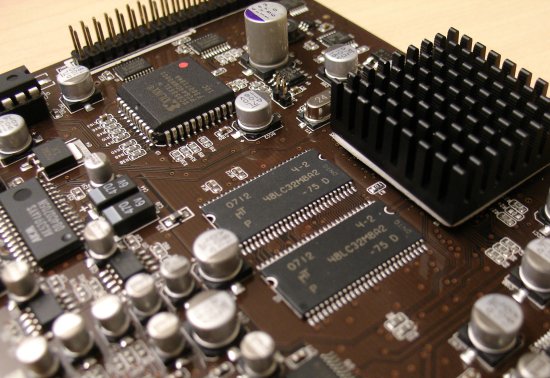
Let's take a look at all the contenders in this roundup, the Auzentech X-Fi Prelude, the Auzentech X-Meridian, and the Creative X-Fi XtremeMusic.
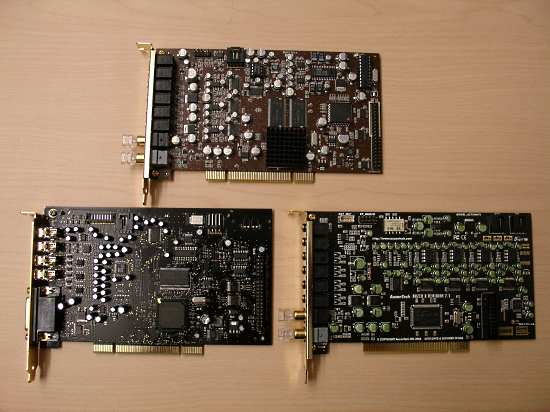
Two X-Fi's and the X-Meridian. In case you think I'm slacking in listing specs, there is no PCIe version here, only PCI.
You can, however expand both the X-Fi Prelude and the X-Meridian with Auzentech's line of extention boards such as the X-Tension DIN card. Auzentech sent us an X-Tension DIN for review some time ago. Frankly I couldn't see the use for the X-Meridian, but for the X-Prelude it does add the missing MIDI interface to go along with all the AudioCreation stuff.
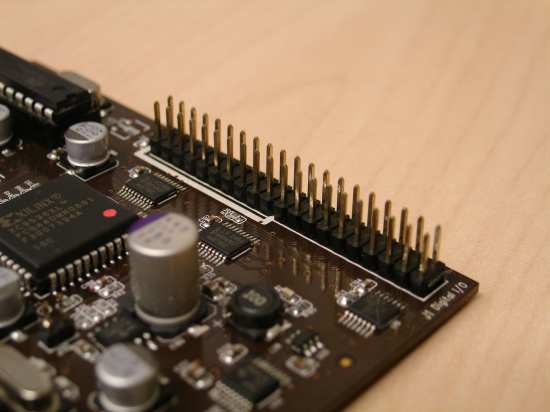
There are several more differences between the garden variety X-Fi and the X-Fi Prelude. Its a bit like a production car versus the track version. Just for fun, let's look at the output sections for the X-Fi XtremeMusic...
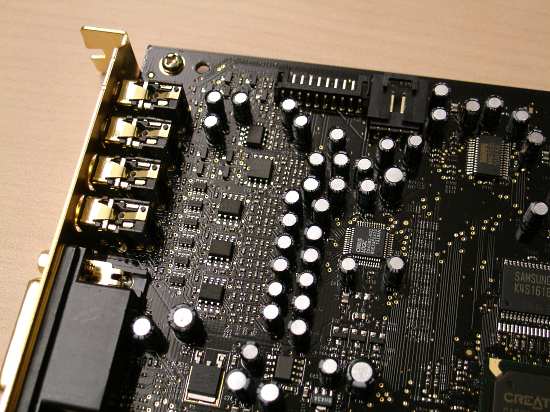
And the X-Fi Prelude.
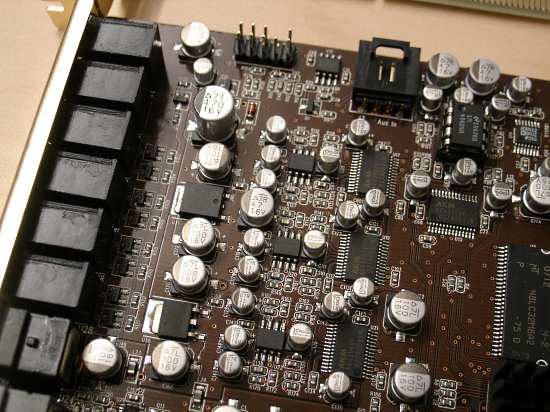
Finally, to round up the hardware features, there's the singature Auzentech replacable op-amps. The X-Meridian featured replacable op-amps on all channels, and the X-Fi Prelude has just the front 2 channels have the replacable op-amp.
